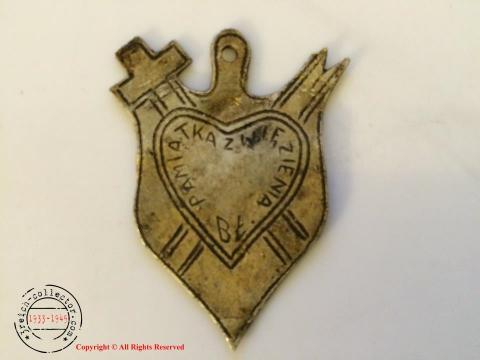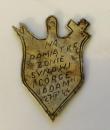Nazi prisons - Rare ground dug pendant with engraved text by prisoner from Błonie prison near Inowroclaw!
| Price: | $230.00 |
Very rare and interesting ground dug pendant, hand made by a Polish prisoner from Błonie prison near Inowroclaw . It reads: "In memory of my wife, son and daughter and the date". On the other side it reads: "In memory from prison BŁ". In perfect condition and found there, in the area formerly occupied by Błonie prison during some excavations carried out there.
We find very good information about this prison :
Various types of camps created by the Germans in the occupied Polish lands were used primarily for the physical liquidation of the prisoners imprisoned in them and for using the work of prisoners for the economic needs of the Third Reich. An extensive camp system operated in the country conquered by German troops. It consisted of thousands of camps and sub-camps, operating according to special criteria of their destination.
German occupation policy took into account, inter alia, creation of extermination camps, where the majority of prisoners arrived were immediately murdered in gas chambers. Mass murders cheap in production and highly deadly cyclone B also took place in concentration camps, where prisoners on a large scale were used, among others to perform all kinds of heavy works. On the other hand, in labor camps - most often branches of concentration and extermination camps - tens of thousands of people were directed to physical labor under human forces, deliberately leading them to death. To these various types of camps there are also penal and isolation, prisoner-of-war (functioning in the first period of occupation), Germanization (so-called Germanization camps in which persons with the second or third group of the German national list) were placed, resettlement or transitional camps. Living conditions prevailing in practically all types of camps contributed to the high mortality of prisoners staying in them. As a result of hunger, cold, terrible hygienic conditions, inhuman treatment (e.g. forcing the sick and the elderly to work), many prisoners died of exhaustion or as a result of spreading diseases (scabies, typhus, typhoid fever, etc.). Hundreds of thousands of people detained in the camps also died on the spot as a result of torture and immediate executions, often carried out for no apparent reason against accidentally selected camp prisoners.
All these elements of Nazi terror also took place in the transit camp built in August and September 1940 in Błonia in Inowrocław - a branch of the Nazi death camp in Stutthof. The Błonia camp was subordinate to the local Gestapo and was created to replace the prisoner-of-war camp and labor camp in Detailed, operating since March 1940. The official official name of the camp put into operation on September 15, 1940 was: Staatspolizeistelle Hohensalza - Übergangslager (Inowrocław State Police Post - Transition Camp). In 1944 it was changed to Polizeigefängnis der Sicherheitspolizei und Arbeitserziehungslager (Security Police Prison and Educational Labor Camp). Both names of the camp in Błonia - "temporary" and "work" do not reflect its actual character. Precisely because of the scale of the terror and the multitude of bestial forms of abuse of people detained here, this place deserves to be more appropriately described as an "extermination camp" or "concentration".











